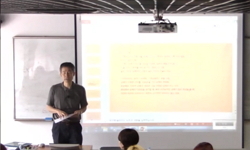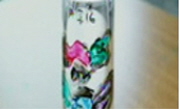현대공예는 쓰임이 있는 기능적 요소와 더불어 예술적 가치로서 표현되어진다. 표현양식은 시대의 변화에 따라 다양화되고 있으며, 많은 작가들에 의해 시도되고 있다. 본인은 이러한 표현...
http://chineseinput.net/에서 pinyin(병음)방식으로 중국어를 변환할 수 있습니다.
변환된 중국어를 복사하여 사용하시면 됩니다.
- 中文 을 입력하시려면 zhongwen을 입력하시고 space를누르시면됩니다.
- 北京 을 입력하시려면 beijing을 입력하시고 space를 누르시면 됩니다.
https://www.riss.kr/link?id=T8890058
- 저자
-
발행사항
서울 : 同德女子大學校 大學院, 2003
-
학위논문사항
학위논문(석사) -- 동덕여자대학교 대학원 , 미술학과 공예(금속)전공 , 2003. 8
-
발행연도
2003
-
작성언어
한국어
- 주제어
-
KDC
632 판사항(4)
-
발행국(도시)
서울
-
형태사항
vi, 45p. : 삽도 ; 26cm.
-
일반주기명
참고문헌: p. 42-43
- 소장기관
-
0
상세조회 -
0
다운로드
부가정보
국문 초록 (Abstract)
'키네틱 아트(Kinetic Art)'는 모든 물체가 스스로 움직이기를 갈망했던 인류의 관심으로부터 발생한 미술장르로서, 움직이는 듯한 시각적 착시현상을 주는 예술과 작품에 실제 움직임이 있는 예술을 포함하고 있다. 그러나 오늘날 우리가 키네틱 아트라고 부르는 것들은 주로 실제의 움직임을 갖고 있는 작품을 일컫고 있다. 즉, 키네틱 아트는 움직임이 개입된 미술을 의미하며, 그것은 전체적인 작품의 구성요소로서의 움직임과 관련된다. 이러한 운동성은 전기와 모터 등 기계적 동력수단을 이용한 움직임과 기계적 수단 없이 사람의 손이나 공기의 유동에 의한 움직임으로 대별될 수 있는데, 후자의 대표적인 작품은 알렉산더 칼더의 '모빌'이다. 우리 나라 장식품 중 일부분에서 나타나는 영락이나 떨새와 같은 움직임은 키네틱 아트에서 보여지는 움직임과는 다른 것으로, 움직임이 작품의 주체가 되는 것이 아니며, 전체에서 일부분의 장식적인 요소로서 움직임이 나타난다. 이와같이 키네틱 아트와 장식적인 흔들림을 보여주는 한국의 장식품는 움직임이라는 공통된 조형요소를 갖는 반면, 운동의 크기와 방법의 차이와 키네틱 아트의 기계적이며 기하학적인 형태, 한국 장신구의 자연적이고 사실적인 형태에서 보여지는 형태적 차이를 볼 수 있다. 이러한 동, 서양의 움직임에 의한 조형적, 형태적 특징을 중심으로 작품을 표현하고자 한다.
본 연구에서는 자연적인 힘에 의한 움직임을 갖는 키네틱 아트와 스프링에 의한 떨림을 보여주는 우리나라 조선시대의 여인용 머리장식을 중심으로 작품의 표현방법을 모색한다. 즉, 모터와 같은 기계적인 힘에 의한 움직임이 아닌, 사람이나 물체의 힘, 흑은 기류나 진동에 의한 자연적 힘으로서 움직임과 변화를 갖는 작품을, 금속재 코일 스프링의 다양한 연결방식을 중심으로 작품을 표현하고 연구한다.
'운동성'이라는 가변적인 요소는 고정된 작품에 비하여 더 다양한 조형적 표현이 가능하게 하며, 또한 사용자로 하여금 보다 많은 흥미를 유발시킬 수 있다. 기능성과 예술성은 물론 가변적인 변화에서 발생하는 재미로 스쳐 지나는 예술이 아닌 관람자가 직접 그 변화를 경험할 수 있게 하는 작품을 제작하는 것이 이 연구의 목적이며, 금속공예 작품에 있어 1차적인 형태적 아름다움과 함께 2차적인 가변성이라는 변화에서 오는 흥미를 함께 찾고자 한다.
현대공예는 쓰임이 있는 기능적 요소와 더불어 예술적 가치로서 표현되어진다. 표현양식은 시대의 변화에 따라 다양화되고 있으며, 많은 작가들에 의해 시도되고 있다. 본인은 이러한 표현양식의 새로운 시도로, 스프링을 사용하여 스프링이 갖는 물성의 특성에 의한 움직임, 잠재적 형태변화를 표현하려 한다. 즉, 변화하기전의 실제의 형태에서 사람이나 물체의 힘이 가해지면 움직임을 보이거나 공간 안에서의 형태변화를 보여주는 것을 말한다. 이와 같은 '움직임, 변화'라는 조형요소는 서양 현대 미술의 '키네틱 아트(Kinetic Art)'와 금관, 화관, 족두리, 떨잠과 같은 한국의 전통 장신구에서 찾아볼 수 있다.
'키네틱 아트(Kinetic Art)'는 모든 물체가 스스로 움직이기를 갈망했던 인류의 관심으로부터 발생한 미술장르로서, 움직이는 듯한 시각적 착시현상을 주는 예술과 작품에 실제 움직임이 있는 예술을 포함하고 있다. 그러나 오늘날 우리가 키네틱 아트라고 부르는 것들은 주로 실제의 움직임을 갖고 있는 작품을 일컫고 있다. 즉, 키네틱 아트는 움직임이 개입된 미술을 의미하며, 그것은 전체적인 작품의 구성요소로서의 움직임과 관련된다. 이러한 운동성은 전기와 모터 등 기계적 동력수단을 이용한 움직임과 기계적 수단 없이 사람의 손이나 공기의 유동에 의한 움직임으로 대별될 수 있는데, 후자의 대표적인 작품은 알렉산더 칼더의 '모빌'이다. 우리 나라 장식품 중 일부분에서 나타나는 영락이나 떨새와 같은 움직임은 키네틱 아트에서 보여지는 움직임과는 다른 것으로, 움직임이 작품의 주체가 되는 것이 아니며, 전체에서 일부분의 장식적인 요소로서 움직임이 나타난다. 이와같이 키네틱 아트와 장식적인 흔들림을 보여주는 한국의 장식품는 움직임이라는 공통된 조형요소를 갖는 반면, 운동의 크기와 방법의 차이와 키네틱 아트의 기계적이며 기하학적인 형태, 한국 장신구의 자연적이고 사실적인 형태에서 보여지는 형태적 차이를 볼 수 있다. 이러한 동, 서양의 움직임에 의한 조형적, 형태적 특징을 중심으로 작품을 표현하고자 한다.
본 연구에서는 자연적인 힘에 의한 움직임을 갖는 키네틱 아트와 스프링에 의한 떨림을 보여주는 우리나라 조선시대의 여인용 머리장식을 중심으로 작품의 표현방법을 모색한다. 즉, 모터와 같은 기계적인 힘에 의한 움직임이 아닌, 사람이나 물체의 힘, 흑은 기류나 진동에 의한 자연적 힘으로서 움직임과 변화를 갖는 작품을, 금속재 코일 스프링의 다양한 연결방식을 중심으로 작품을 표현하고 연구한다.
'운동성'이라는 가변적인 요소는 고정된 작품에 비하여 더 다양한 조형적 표현이 가능하게 하며, 또한 사용자로 하여금 보다 많은 흥미를 유발시킬 수 있다. 기능성과 예술성은 물론 가변적인 변화에서 발생하는 재미로 스쳐 지나는 예술이 아닌 관람자가 직접 그 변화를 경험할 수 있게 하는 작품을 제작하는 것이 이 연구의 목적이며, 금속공예 작품에 있어 1차적인 형태적 아름다움과 함께 2차적인 가변성이라는 변화에서 오는 흥미를 함께 찾고자 한다.
다국어 초록 (Multilingual Abstract)
But today's kinetic art means mainly the work of art that can move in reality. In other words, kinetic art means the art related with movement and it is also related with movement as components for the whole work. This movement can be divided into the movement by mechanical power like electricity or motor and the movement by natural power like person's hand or the flow of air.
Dduljam, which is hair accessory for women in late Chosun dynasty, shows both kinetic art and movement in common. But kinetic art searches for mechanical form and uses movement as the whole component part. On the other hand, Dduljam expresses natural form realistically and quivering of an ornament in shape of birds on it shows movement as decorative purposes.
In this study, I would like to express formative feature of kinetic art and Dduljam together as work showing movement and variableness getting out of metal work that can't move. I have studied chiefly work that is moved and varied by natural power, such as person's or object's energy, flow of air, or vibration, not by mechanical power, such as motor.
To express variable formative component, I chose spring as a material and applied it to work through various sampling and experiment. Spring can be moved by natural power and I applied spring, which can make a space by a regular twist with only a line in one dimension, to work as a very interesting part. There are many kinds of spring. But in this study, I tried to show coordinating form as appling to work restricting within coil spring. On the other hand, I have studied the way to connect springs and composition in various way.
The variable component, that is, movement, makes it possible much more various formative expression than fixed work. It also attracts people's interest pretty more. It is the purpose of this study and I search for both the formative beauty as a first step and interest from variableness as a second step in metal craftwork.
Mankinds have expected all things that they made can move for themselves. Perhaps A water mill is the first work from this hope, and then the movement is getting bigger and bigger through the invention such as clock, steam engine, and car. This mankin...
Mankinds have expected all things that they made can move for themselves. Perhaps A water mill is the first work from this hope, and then the movement is getting bigger and bigger through the invention such as clock, steam engine, and car. This mankinds' dream can make people think of possibility of movement even for work of art like painting, engraving or sculpture considered not to move without doubt. "Kinetic art", which comes from mankind's interest about movement, includes not only the art that moves in reality but also the art that looks moving because of optical illusion. Op Art, the former, isn't move in reality but is a kind of the illusion art made by tension and movement of optic angle that comes from the relation of form, shade, color, and line.
But today's kinetic art means mainly the work of art that can move in reality. In other words, kinetic art means the art related with movement and it is also related with movement as components for the whole work. This movement can be divided into the movement by mechanical power like electricity or motor and the movement by natural power like person's hand or the flow of air.
Dduljam, which is hair accessory for women in late Chosun dynasty, shows both kinetic art and movement in common. But kinetic art searches for mechanical form and uses movement as the whole component part. On the other hand, Dduljam expresses natural form realistically and quivering of an ornament in shape of birds on it shows movement as decorative purposes.
In this study, I would like to express formative feature of kinetic art and Dduljam together as work showing movement and variableness getting out of metal work that can't move. I have studied chiefly work that is moved and varied by natural power, such as person's or object's energy, flow of air, or vibration, not by mechanical power, such as motor.
To express variable formative component, I chose spring as a material and applied it to work through various sampling and experiment. Spring can be moved by natural power and I applied spring, which can make a space by a regular twist with only a line in one dimension, to work as a very interesting part. There are many kinds of spring. But in this study, I tried to show coordinating form as appling to work restricting within coil spring. On the other hand, I have studied the way to connect springs and composition in various way.
The variable component, that is, movement, makes it possible much more various formative expression than fixed work. It also attracts people's interest pretty more. It is the purpose of this study and I search for both the formative beauty as a first step and interest from variableness as a second step in metal craftwork.
목차 (Table of Contents)
- 국문초록 = ⅰ
- 목차 = ⅲ
- Ⅰ. 서론 = 1
- 1. 연구 목적 = 1
- 2. 연구 내용 및 방법 = 2
- 국문초록 = ⅰ
- 목차 = ⅲ
- Ⅰ. 서론 = 1
- 1. 연구 목적 = 1
- 2. 연구 내용 및 방법 = 2
- Ⅱ. 본론 = 4
- 1. 키네틱 아트(Kinetic Art)의 조형적 특질 = 4
- 1) 키네틱 아트의 발생 = 4
- 2) 움직임의 원리에 따른 키네틱 아트 = 5
- ① 자연적인 힘에 의한 움직임 = 5
- ② 기계적인 힘에 의한 움직임 = 7
- 3) 키네틱 아트의 조형적 특성 = 8
- 2. 조선시대 여인용 장식품에 나타난 움직임의 조형적 특성 = 13
- 1) 우리 나라 전통공예품에 나타난 움직임의 조형성 = 13
- 2) 스프링을 이용한 움직임이 표현된 조선시대 여인용 장식품 = 13
- 3. 탄성의 물리적 성질과 스프링의 재료 연구 = 16
- 1) 탄성(elasticity) = 16
- 2) 스프링의 일반적 특징과 종류 = 17
- ① 코일 스프링(coiled spring)의 종류 = 18
- 4. 작품 제작 및 작품 설명 = 21
- 1) 작품 제작 의도 = 21
- 2) 작품에 적용된 스프링의 연결방법 = 22
- 3) 작품 설명 = 24
- Ⅲ. 결론 = 40
- <참고문헌> = 42
- ABSTRACT = 44












